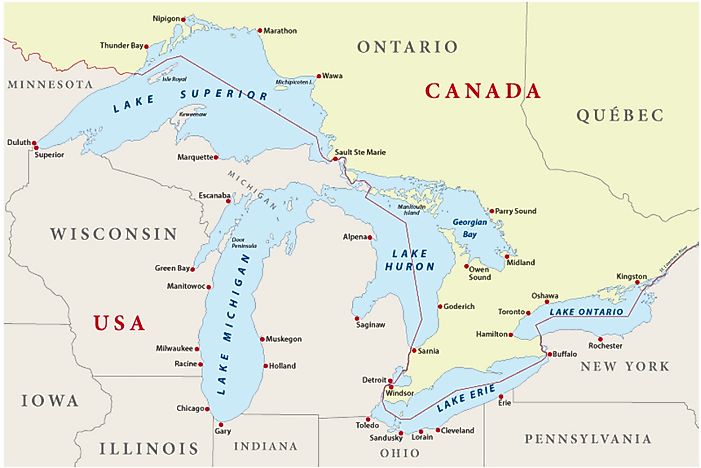Huron-Ontario-Michigan-Erie-Superior
Make sure you review all parts of this assignment.
What you turn in should be neat and easy to read.
1. Where are the Great Lakes located?
2. How does the geographic location of the Great Lakes lead to the uniqueness of each lake?
3. Trace the path or journey a raindrop might take from Lake Superior to the Atlantic Ocean. What different sights and species might it encounter along the way?
4. What kinds of efforts might be required to protect the Great Lakes and who would benefit from these measures?
5. Which of the Great Lakes is the largest, containing half of all the water in the system?
6. How much of Earth’s available fresh surface water do the Great Lakes contain?
7. Where does the water in the Great Lakes eventually end up?
__________________________________________________________________________________________
Great Lakes Quest - You will put all your answers on a big piece of paper. This is not to be done on a doc.
Directions are below the pictures.
Alliance for the Great Lakes- This is a local organization advocating for the Great Lakes and the people living around them. There are many opportunities for citizen science and students to get involved.


Which direction is the water from the Great Lakes flowing?
1. On a big piece of paper draw out the above pictures.. Label all parts. (Do your best.) Add the direction of flow to your map putting numbers next to the lakes from first to last in the direction. Add a compass rose to your map. (The direction of flow arrow at the top points East.) Put the Lakes in order of flow and label all the states and provinces a(in Canada) around them.
2. Click on Physical Features of the Great Lakes and looing at the numbers for average depth and maximum depth put the lakes in order of size from smallest to largest.
3. Click on The Great Lakes. Looking at the section for Environmental Issues pick one of them and describe how that issue is impacting the Great Lakes.
4. Click on the Get Involved Section of Alliance for Great Lakes. How can you speak out for the Great Lakes? Click on one of the action items and describe what you can do.
5. Go to the article Maps of Great Lakes Shipwrecks detail one of North America's biggest Graveyards.
* Take notes on the data given about the Great Lakes and add them to your Great Lakes poster. There is a lot of information so take your time.
*Add 3 shipwrecks and where on the lakes to each of the Great Lakes. Lake Michigan has the most shipwrecks.
6. Go to the site for the Great Lakes Shipwreck Museum and add where it is found to your map and summarize one of the articles discussed on the main site.
7. Listen and read the words to this song. The Wreck of the Edmund Fitzgerald. This is a song about a shipwreck in the great lakes by Gordon Lightfoot. Find another song about a ship wreck and give me the link and name. Where did it go down? (See below for a link for help.)
If you are interested in the Great Lakes History check out Lee Murdock. He tells stories of shipwrecks through music.
_____________________________________________________________________________
For the Documentary Drain the Great Lakes found below do the following:
Take notes on information given on each of the great lakes.
Turn in an organized chart made using your notes of the information provided.
- Notes first
- Organized table with information learned as categories on the table.
Now you will research an environmental issue affecting Lake Michigan.
- In your research describe policies that each state bordering the lake have.
- For your research you should have at least 3 sources only one of them being a video.
- Your research should be described in a paper of 5 paragraphs, double spaced, 12 font.
- Paragraphs: Introduction, 3 paragraphs describing the different aspects of the issue, final thoughts and possible solutions.